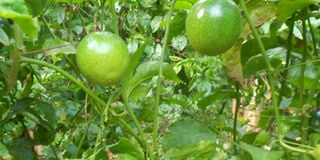How to grow the yellow passion fruits

Yellow passion fruit gives a delicious juice and its flavour blends easily with other tropical fruits such as bananas, pineapples or mangoes.
They grow well in lowlands and mid altitude areas.
Although the fruit is in great demand locally and globally, production and yields remain low, partly because of limited access to quality planting material, short orchard lifespan (24 months) due to woodiness virus disease and poor agronomic practices.
With the rainy season here, leading agronomists strongly advise farmers to consider the yellow passion fruit.
Varieties
There are three main varieties as KPF4, KPF11, KPF12 but KPF4 and KPF12 have been commercialized and command greater preference due to their high quality yields.
KPF4 has light green leaves and vines, oval fruits and deep yellow pulp. KPF12 has dark green leaves and vines, round fruits, yellow pulp and heavy flowering and fruiting.
How to prepare the seed
Cut the fruit into half, extract the pulp, and use clean water to separate the pulp from the seeds. Rinse at least three times to avoid sticking on the drying surface. Put the washed seed on a piece of cloth and dry at room temperature away from direct sunlight.
The seeds should be planted immediately or within 30 days after extraction to maintain viability.
The seeds should be planted directly into bio gradable planting bags by placing the seed 1cm into the soil. This would help reduce the shock of transplanting.
Do not plant your seedlings in the neighborhood of adult passion fruit plants to avoid infection with the woodiness virus and ensure that there is enough light for the new plants.
Land preparation
Planting holes should be dug to give the orchard an east west orientation. The holes should be at least 0.6m deep and 4m spacing.
Larger spacing of the posts should be avoided as this would lead to collapsing of the trellising system. The post should be 2.5m in length and 15cm diameter with total height above the soil being 1.9m
The vines should be transplanted 25- 30cm height. The time for attaining the height varies with region but it is about two to three months. Planting vines at a spacing of 1.5X2.5m will result into a plant population of 1,064 vines per acre compared to the conventional 740 vines per acre derived from a spacing of 3x2m.
Management
Remove shoots and tendrils from the seedlings on a weekly basis until they reach the trellising wire.
Use hands to prune shoots and tendrils to minimize the spread of diseases. Remove the tendrils up to 50cm from the trellising wire.
This provides less resistance to the wind. Prune secondary laterals 10- 40com from the ground to avoid pests and diseases. This also eases the harvest process.
Effective water management increases flowering and curbs flower abortion. Incorporate cost effective water management systems and practices to increase soil water retention and minimize crop water stress.
Increase fruit formation by adopting hand pollination. It should be done regularly as when emerging flowers bloom. This increases yields by 30 per cent.
Julius Mukasa, a farmer who has specialised in the yellow passion fruits in Luweero advises farmers to continuously prune the crop. “Pruning, irrigation and supply of manure after every three months is very vital,” says Mukasa who has planted eight acres.
Pests and pests and disease control
Thrips, phytophthora blight and brown spots are the major pests and diseases of passion fruits, use clean planting materials, copper based fungicide sprays during the rainy season. Field hygiene is recommended. Use of bio- pesticides is encouraged for minimum residue limit incidence.
Use integrated pest management techniques such as orchard sanitation and physical control such as use of insecticide treated net and sleeve. Drench the planting hole with trichoderma at 1ml of water before transplanting the seedling.
Apply Bacillus subtillis to control brown spots at vegetative stages at 1ml or water. Apply metarrhizium strain 69 to control thrips and sting bugs. Minimize the spread of woodiness virus using hand pruning during the first six months.
Harvesting
To harvest for processing, collect mature fallen fruits from the ground. To harvest fresh fruits for a fresh market, harvest directly from the vine at 70 per cent ripe, when the fruit attains the yellow colouration. The fruits should be harvested and transported in plastic crates. Avoid harvesting, transportation and storage of fruits in gunny bags to minimize post-harvest losses.
Yellow vs purple passion fruits
Although the yellow passion fruit is more popularly grown in Kenya than in Uganda, Julius Peter Ahangaana, a specialist in passion fruit growing says the trend has shifted due to the increasing demand for the yellow passion fruit and more Ugandans are also adopting it.
According to Ahangaana, the aroma in the purple passion fruit has made it remain highly demanded in Uganda. It is also said to give higher yields than the yellow passion fruit. The acid content in the yellow passion fruit is much higher than that in the purple fruit.
He says, “The purple passion fruit withstands extreme weather like too much sunshine, can grow on any type of soil and has a longer lifespan if well cared for but the yellow fruit needs a lot of water and a shorter lifespan. This is the reason it is not popular in Uganda.”




